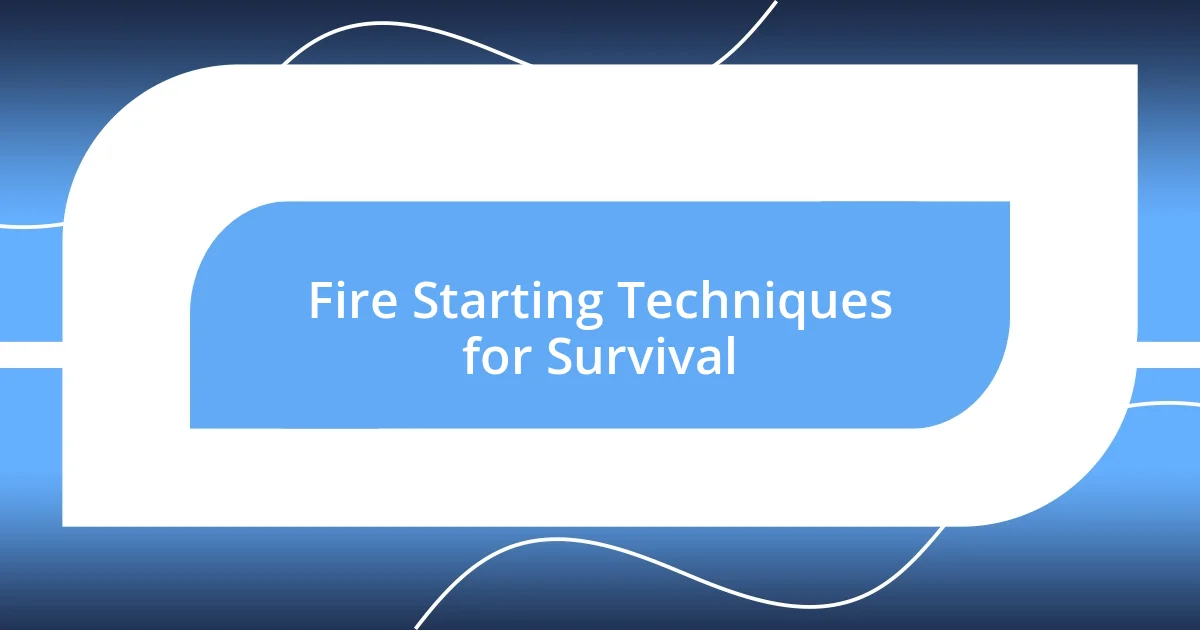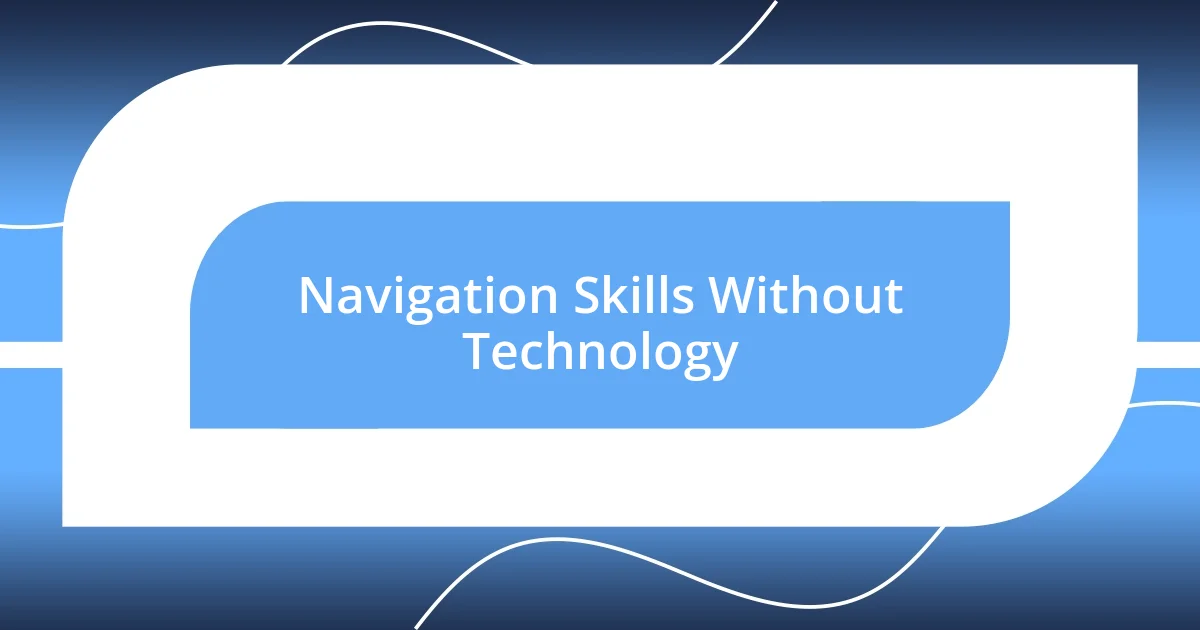Key takeaways:
- The importance of mental resilience and emotional management in survival situations, alongside physical skills.
- Essential survival gear includes a multi-tool, water filtration system, and a well-stocked first-aid kit, emphasizing practicality over luxury.
- Effective techniques for sourcing, purifying water, starting a fire, foraging for food, and navigating without technology are crucial for wilderness survival.

Understanding Outdoor Survival Skills
Understanding outdoor survival skills goes beyond just knowing how to start a fire or find water. I remember the first time I was truly challenged in the wilderness—my heart raced as I realized I was lost. That moment taught me that survival skills are as much about mental resilience as they are about physical techniques.
Have you ever found yourself in a situation where your instincts kicked in? I have. When I had to signal for help using only a whistle and a mirror, it struck me how important creativity is in survival. It’s not just about the gear you carry; it’s about adapting to your environment and using what you have at your disposal.
Emotional management is another crucial aspect of survival that often gets overlooked. When I was out camping and a sudden storm hit, I had to harness my anxiety to stay calm and make smart decisions. How would you cope under pressure? Understanding and controlling your emotions in stressful situations can be the difference between panic and effective action.

Essential Survival Gear
Essential Survival Gear is more than just a list of items; it reflects your preparedness and ability to face the wilderness. I remember my first solo hike, armed with a basic survival kit. A sturdy multi-tool made all the difference when I found myself needing to build a shelter. Its versatility provided me not only with tools for cutting and prying but also with a sense of confidence, knowing I had what I needed to tackle unexpected challenges.
When choosing gear, I often think about practicality over luxury. For instance, a reliable water filtration system can be a game-changer. I learned this the hard way on an extended trip when I underestimated the importance of clean water. Carrying heavy bottles was exhausting, and the lightweight filter I eventually purchased saved me in future outings. It’s these little decisions that can significantly impact your experience in the wild.
Lastly, I can’t stress enough the importance of a first-aid kit. You never know when a minor cut can turn into a major problem, particularly in remote areas. The last time I went camping, I tripped and scraped my knee pretty badly. Thankfully, my first-aid kit was well stocked, allowing me to clean the wound and avoid potential infection. I urge you to tailor your kit to your needs, incorporating items that resonate with your adventures.
| Gear | Benefits |
|---|---|
| Multi-Tool | Versatility for various tasks |
| Water Filter | Ensures access to potable water |
| First-Aid Kit | Essential for injury management |

Water Sourcing and Purification
Water is the lifeblood of any survival situation, and sourcing it often becomes your top priority. I still recall a time when I was hiking through a dry valley, the sun bearing down on my neck, and I realized I’d forgotten to check my water supply. The rush of panic was intense. Thankfully, I remembered that nearby areas often contain hidden sources like streams or puddles after rainfall. It taught me to always be vigilant and aware of my surroundings.
To purify the water you find, the techniques can range from basic to advanced. Depending on the situation, I’ve relied on several methods that have worked effectively for me:
- Boiling: If safe to do so, boil water for at least one minute. I remember feeling so relieved when I watched that steam rise; it was a simple way to ensure safety.
- Filtration Systems: These lightweight tools can turn murky water into something drinkable. On one expedition, I was grateful to have a portable filter, as it saved me from dehydration.
- Chemical Purification: Use water purification tablets if access to fire isn’t feasible. I always carry a few in my kit; they provide peace of mind in uncertain situations.
No matter how you choose to source and purify your water, remember that staying hydrated is essential for maintaining both physical and mental strength in the wild.

Fire Starting Techniques for Survival
Starting a fire in a survival situation can be a tremendous boost to morale. I vividly recall a chilly night camping in the wilderness; the temperature was plummeting, and I felt a sense of urgency as I gathered dry leaves and twigs. Using a magnesium fire starter, I struck it against my knife, and the spark turned into a warm flame. That moment felt like magic and reinforced the importance of having reliable tools. Have you ever experienced that rush of warmth from a fire after a long day outdoors?
Another technique that works wonders is the classic bow drill method. I remember the frustration of not getting it right on my first try – it took several attempts and a lot of perseverance. The key? A softwood base combined with a hardwood spindle to create the right friction. Once I felt that tiny ember form, my adrenaline surged. It’s a skill that requires patience but can be incredibly rewarding. Have you ever felt the satisfaction of creating fire solely from friction? It’s something you won’t forget.
Using everyday items can also facilitate fire starting. On one unforgettable hike, I discovered that a simple cotton ball soaked in petroleum jelly ignited almost effortlessly. I keep a few in my pack now, and they’ve saved me more than once. Each time I light a fire, whether through the traditional methods or using quick hacks, I can’t help but feel a sense of triumph. What techniques resonate with you for harnessing fire in the wild?

Foraging for Edible Plants
Foraging for edible plants has always fascinated me, and I find it one of the most rewarding aspects of survival skills. I remember the first time I successfully identified wild garlic during a hike; the rush of excitement was palpable. The pungent scent was unmistakable, and I couldn’t wait to use it in the stew I was cooking at camp that evening. Isn’t it exhilarating to realize that the land can provide so many hidden treasures if you just know where to look?
One of the most important lessons I’ve learned is to never rush the foraging process. I once picked what I thought was a delicious wild berry, only to realize later that it was an inedible variety. The bitter taste lingered longer than I expected! This experience taught me the value of proper research and identification. Remember, certain plants can look alarmingly similar, so taking the time to ensure what you’re foraging is safe can make all the difference.
Every outing brings the chance for new discoveries. On a recent camping trip, I stumbled upon a patch of dandelions bursting with bright yellow blossoms. I couldn’t believe my luck! Not only did I gather a handful for tea, but I also sautéed the leaves for a fresh salad. The satisfaction of transforming wild plants into a nutritious meal felt empowering. How often do you find yourself connecting with nature through the food you gather? It’s truly a unique experience that fosters both appreciation and survival skills.

Navigation Skills Without Technology
Navigating without technology has its own charms and challenges. One evening, while lost in a dense forest, I remembered the age-old technique of using the stars to find my way. Gazing up, I spotted the North Star, which guided me homeward. Have you ever felt that indescribable connection to the natural world when looking up at the sky for guidance?
Another essential skill is observing the landscape. I recall a time traversing through a valley where the sun’s position helped me gauge the direction of my journey. By recognizing the way shadows cast across hillsides, I was able to steer clear of getting turned around. It’s fascinating how our surroundings can provide clues; have you ever noticed how rivers often flow northward? That’s a testament to the importance of keen observation.
Using a simple map and compass is also a valuable practice, and I’d encourage anyone to try it. I still remember the rush of excitement when I accurately triangulated my position on a topographical map for the first time. Understanding the terrain and elevation can be so thrilling. What if stepping away from technology not only sharpened our navigation skills but also deepened our appreciation for the environment around us?














